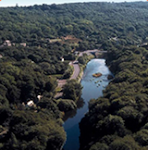
 This is an area that most of us didn't realise existed. Rich in wildlife and like many of our precious green and brown spaces is under threat from developers. It would be a real pity if this was to disappear under brick and mortar.
This is an area that most of us didn't realise existed. Rich in wildlife and like many of our precious green and brown spaces is under threat from developers. It would be a real pity if this was to disappear under brick and mortar.The various meadows are abundant with insects with the surrounding areas awash with interesting plants.

 Small woodlands also offer an interesting foray
Small woodlands also offer an interesting foray Once the rain started to abate and the temperature warmed a little the butterfly life awoke and within minutes scores of Ringlets and Meadow Browns took to the air dancing and flitting over the tall grasses, the males searching for mates and the females laying their eggs.
Once the rain started to abate and the temperature warmed a little the butterfly life awoke and within minutes scores of Ringlets and Meadow Browns took to the air dancing and flitting over the tall grasses, the males searching for mates and the females laying their eggs.
Small and Large Skippers soon joined in. Both Nigel and I managed to click a pair of mating Small Skippers

There were many other invertebrates as well, of course;

 Talking of Ladybirds did everyone notice the abundance of little orange and black 'diddly things'? They seemed to be everywhere.
Talking of Ladybirds did everyone notice the abundance of little orange and black 'diddly things'? They seemed to be everywhere.I was pretty sure they were insect pupae as the discarded larval skin could be seen attached to one end and glued to a leaf. I can confirm (as Nigel's pic here informs) that these were indeed 7-spot Ladybird pupa. The other pic (again from Nigel) is a larva of the same.
As mentioned in an earlier post just about every Friday someone manages to finish up up in a somewhat ungainly heap on the ground. This week it was Lis's turn...
 I think she's saying; "I'll be fine if Keith could just take his foot off my ankle", but I could be wrong of course! Hope you're OK Lis after your skid and tumble!
I think she's saying; "I'll be fine if Keith could just take his foot off my ankle", but I could be wrong of course! Hope you're OK Lis after your skid and tumble!So as another great WuFuV day comes to an end we all hope that this fascinating area is saved and preserved for many generations to come
 Announcements
AnnouncementsThe more I learn about the fascinating lives of moths the more I want to know! I think we all have a thirst for absorbing as much as we can about everything wildlife, and insects - particularly Lepidoptera - are my particular passion.
Although we're by no means experts Les and I are going to be running 2 moth nights in the near future - dates to be announced. One at Apley Castle and the other at Telford Town Park. As soon as we have everything finalised I'll let Pete know so that he can contact the network. Open to everyone no matter what level of interest.
Garden Moth Scheme
Moth traps the country over are seeing ever-increasing visits from ever-increasing species as the season's weeks go by. My own count last Friday was a total of 90 moths across 26 species - my highest so far. I've uploaded 9 months to the Yahoo Group (Moths Album).
On the run-up to a Moth-training day held by Dave Grundy at Alveley I was convinced we'd be actually learning how to train moths to perform all sorts of tricks and inspired by this somewhat misguided notion I set up the world's first Moth Display Team. This is the first picture released from the recent photo-shoot:-
 I'd obviously got the wrong end of the stick again as it turned out we were there to learn how to ID moths, where to find certain species and to be generally over-awed by Dave's knowledge of the subject which is immense. Oh well, maybe someone somewhere can make use of my new-found talent. Trouble is - I just don't know how long I can keep the team together!
I'd obviously got the wrong end of the stick again as it turned out we were there to learn how to ID moths, where to find certain species and to be generally over-awed by Dave's knowledge of the subject which is immense. Oh well, maybe someone somewhere can make use of my new-found talent. Trouble is - I just don't know how long I can keep the team together!Location Competition
One final picture. Where is this? First with the correct answer wins yet another of my fab prizes from my little box of give-aways. Just drop a comment below. Can't see the comments? You need to go to the main blog www.wrekinforestvolunteers.com
 Nigel has uploaded some more great pics from the day at Beanhill to the Wrekin Forest Volunteers Yahoo Group (Beanhill Album) http://groups.yahoo.com/group/wfv/photos/album/1482490430/pic/list
Nigel has uploaded some more great pics from the day at Beanhill to the Wrekin Forest Volunteers Yahoo Group (Beanhill Album) http://groups.yahoo.com/group/wfv/photos/album/1482490430/pic/listHere's my selection
































